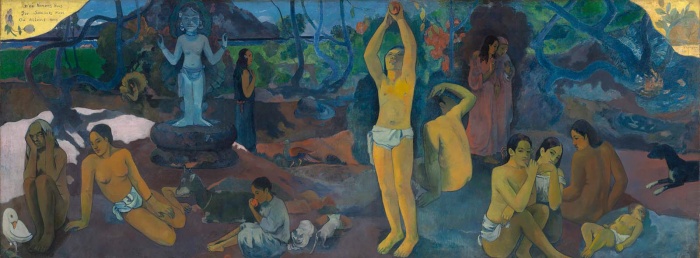Download (PDF, 3.98MB)
A NOTE FROM THE AUTHOR:
When he was between the ages of 11 and 16, Paul Gauguin attended a Catholic boarding school in France. At the school, the Bishop of Orléalns himself taught the class in liturgy. The bishop had devised a catechism in which three main questions were asked: “Where does humanity come from? Where is it going? How do we proceed?”
It is possible that these questions influenced Gauguin when, many years later, he began an enormous painting whose title asked very similar questions.
By this time Gauguin had become an influential post-impressionist artist, the leader of the symbolist movement.
Gauguin was admired by a small circle of artists but, like his close friend Vincent van Gogh, he was unrecognized by the larger public until after his death.
In 1891, when he began the huge painting, Gauguin was living on the island of Tahiti, where he had gone in search of a society free from European prejudices.
Dogged by failing health and financial worries, he planned to commit suicide after finishing what he regarded as his best painting. He did, indeed, attempt suicide by taking an overdose of arsenic, but the attempt failed, and he lived until 1903.

Gauguin’s famous painting can symbolize the questions that humans throughout the ages have asked. Is there a purpose to life? What is our place in nature? Is the earth the center of the universe? What will happen in the future? Are humans special, or are the similar to other animals? Is human nature good or evil? Why do we sometimes act with loving care, and at other times commit genocides? Can war be eliminated? Both science and religion have proposed answers to these central questions.
Most thoughtful observers today believe that human civilization is entering a period of crisis. As all indices move exponentially upward, including population, industrial production, scientific development and the power of technology over nature, the problem of achieving a stable and peaceful world remains serious, challenging and unsolved.
Can humanity and the biosphere survive the todays explosive growth of population and industry? Can we escape the twin threats of catastrophic climate change and thermonuclear war? Can we avoid a large-scale famine caused by population growth, climate change and the end of the fossil fuel era? Where do we come from? What are we? Where are we going?
Regardless of whether the earth has a special importance when viewed on the scale of our fathomless universe, it is certainly important to us, and to the plants and animals with which we share the gift of life.
None of us would wish to see a fatally damaged earth or a dystopian future. We give loving care to our children, but it makes no sense to do so if we neglect to do all that is within our power to give them a future in which they and their descendants can survive.
None of us asked to be born into an age of crisis, but history has given an enormous responsibility to our generation. In addition to the ordinary work that we do in order to put bread on the table and pay the rent, each of us has another job: We must work with dedication to save the future.
I have written a book exploring these questions.
We thank John Scales Avery, a renowned intellectual, EACPE board member, and theoretical chemist at the University of Copenhagen, for giving us permission to reproduce his new book for EACPE.









